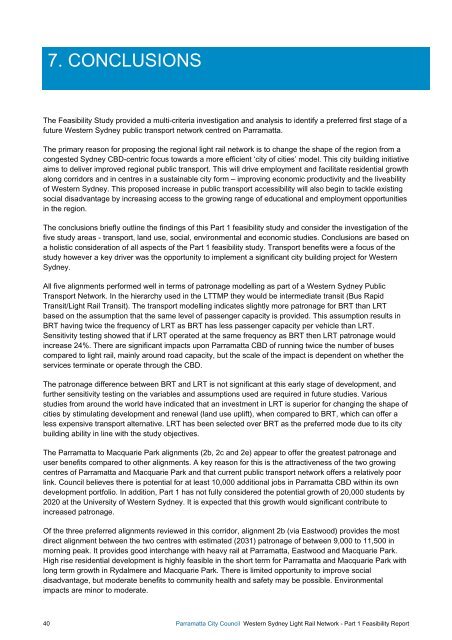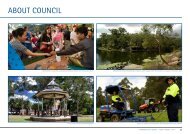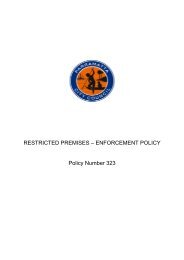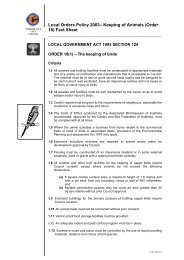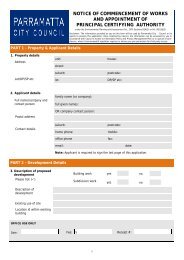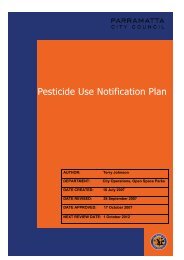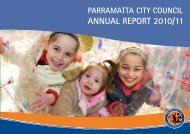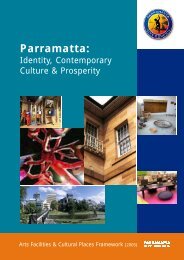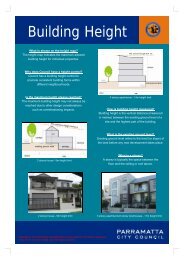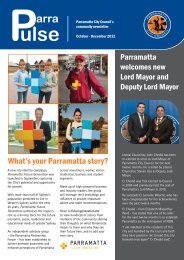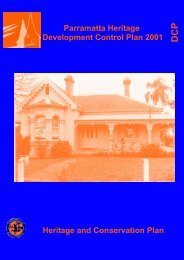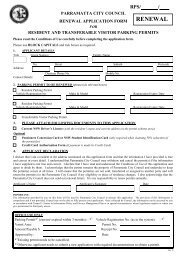Part 1 Western Sydney Light Rail Feasibility Report - Parramatta City ...
Part 1 Western Sydney Light Rail Feasibility Report - Parramatta City ...
Part 1 Western Sydney Light Rail Feasibility Report - Parramatta City ...
You also want an ePaper? Increase the reach of your titles
YUMPU automatically turns print PDFs into web optimized ePapers that Google loves.
7. onclusions7. CONCLUSIONSThe <strong>Feasibility</strong> Study provided a multi-criteria investigation and analysis to identify a preferred first stage of afuture <strong>Western</strong> <strong>Sydney</strong> public transport network centred on <strong>Parramatta</strong>.The primary reason for proposing the regional light rail network is to change the shape of the region from acongested <strong>Sydney</strong> CBD-centric focus towards a more efficient ‘city of cities’ model. This city building initiativeaims to deliver improved regional public transport. This will drive employment and facilitate residential growthalong corridors and in centres in a sustainable city form – improving economic productivity and the liveabilityof <strong>Western</strong> <strong>Sydney</strong>. This proposed increase in public transport accessibility will also begin to tackle existingsocial disadvantage by increasing access to the growing range of educational and employment opportunitiesin the region.The conclusions briefly outline the findings of this <strong>Part</strong> 1 feasibility study and consider the investigation of thefive study areas - transport, land use, social, environmental and economic studies. Conclusions are based ona holistic consideration of all aspects of the <strong>Part</strong> 1 feasibility study. Transport benefits were a focus of thestudy however a key driver was the opportunity to implement a significant city building project for <strong>Western</strong><strong>Sydney</strong>.All five alignments performed well in terms of patronage modelling as part of a <strong>Western</strong> <strong>Sydney</strong> PublicTransport Network. In the hierarchy used in the LTTMP they would be intermediate transit (Bus RapidTransit/<strong>Light</strong> <strong>Rail</strong> Transit). The transport modelling indicates slightly more patronage for BRT than LRTbased on the assumption that the same level of passenger capacity is provided. This assumption results inBRT having twice the frequency of LRT as BRT has less passenger capacity per vehicle than LRT.Sensitivity testing showed that if LRT operated at the same frequency as BRT then LRT patronage wouldincrease 24%. There are significant impacts upon <strong>Parramatta</strong> CBD of running twice the number of busescompared to light rail, mainly around road capacity, but the scale of the impact is dependent on whether theservices terminate or operate through the CBD.The patronage difference between BRT and LRT is not significant at this early stage of development, andfurther sensitivity testing on the variables and assumptions used are required in future studies. Variousstudies from around the world have indicated that an investment in LRT is superior for changing the shape ofcities by stimulating development and renewal (land use uplift), when compared to BRT, which can offer aless expensive transport alternative. LRT has been selected over BRT as the preferred mode due to its citybuilding ability in line with the study objectives.The <strong>Parramatta</strong> to Macquarie Park alignments (2b, 2c and 2e) appear to offer the greatest patronage anduser benefits compared to other alignments. A key reason for this is the attractiveness of the two growingcentres of <strong>Parramatta</strong> and Macquarie Park and that current public transport network offers a relatively poorlink. Council believes there is potential for at least 10,000 additional jobs in <strong>Parramatta</strong> CBD within its owndevelopment portfolio. In addition, <strong>Part</strong> 1 has not fully considered the potential growth of 20,000 students by2020 at the University of <strong>Western</strong> <strong>Sydney</strong>. It is expected that this growth would significant contribute toincreased patronage.Of the three preferred alignments reviewed in this corridor, alignment 2b (via Eastwood) provides the mostdirect alignment between the two centres with estimated (2031) patronage of between 9,000 to 11,500 inmorning peak. It provides good interchange with heavy rail at <strong>Parramatta</strong>, Eastwood and Macquarie Park.High rise residential development is highly feasible in the short term for <strong>Parramatta</strong> and Macquarie Park withlong term growth in Rydalmere and Macquarie Park. There is limited opportunity to improve socialdisadvantage, but moderate benefits to community health and safety may be possible. Environmentalimpacts are minor to moderate.40 <strong>Parramatta</strong> <strong>City</strong> Council <strong>Western</strong> <strong>Sydney</strong> <strong>Light</strong> <strong>Rail</strong> Network - <strong>Part</strong> 1 <strong>Feasibility</strong> <strong>Report</strong>


